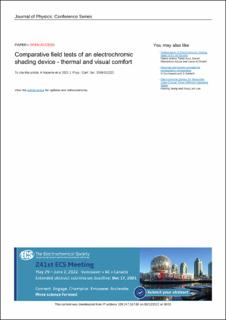| dc.contributor.author | Nocente, Alessandro | |
| dc.contributor.author | Oksavik, Odne Andreas | |
| dc.contributor.author | Gullbrekken, Lars | |
| dc.contributor.author | Grynning, Steinar | |
| dc.date.accessioned | 2021-12-09T08:00:36Z | |
| dc.date.available | 2021-12-09T08:00:36Z | |
| dc.date.created | 2021-12-08T07:05:34Z | |
| dc.date.issued | 2021 | |
| dc.identifier.issn | 1742-6588 | |
| dc.identifier.uri | https://hdl.handle.net/11250/2833486 | |
| dc.description.abstract | Electrochromic devices (EC), or Smart Windows, are amongst the most promising technologies to increase users' wellbeing in buildings. A comparative test of EC windows performance was realised in the ZEB Test Cell Laboratory in Trondheim, Norway. Two identical rooms were used for the comparative tests. One of the rooms was equipped with EC devices. The other room was equipped with a traditional insulated glazing unit (IGU) with external solar shading device. Three automatic control strategies were tested in this experiment. The EC device demonstrated a good impact on the thermal and visual comfort when compared to a traditional IGU without moveable shading and a traditional IGU with an external screen. | |
| dc.language.iso | eng | |
| dc.publisher | IOP Publishing | |
| dc.rights | CC BY 3.0 | |
| dc.rights.uri | https://creativecommons.org/licenses/by/3.0/ | |
| dc.title | Comparative field tests of an electrochromic shading device - thermal and visual comfort | |
| dc.type | Peer reviewed | |
| dc.type | Journal article | |
| dc.description.version | publishedVersion | |
| dc.rights.holder | © 2021 The authors | |
| dc.subject.nsi | VDP::Teknologi: 500 | |
| dc.source.volume | 2069 | |
| dc.source.journal | Journal of Physics: Conference Series (JPCS) | |
| dc.identifier.doi | 10.1088/1742-6596/2069/1/012222 | |
| dc.identifier.cristin | 1965879 | |
| dc.relation.project | Norges forskningsråd: 282351 | |
| dc.source.articlenumber | 012222 | |
| cristin.ispublished | true | |
| cristin.fulltext | original | |
| cristin.qualitycode | 1 | |

